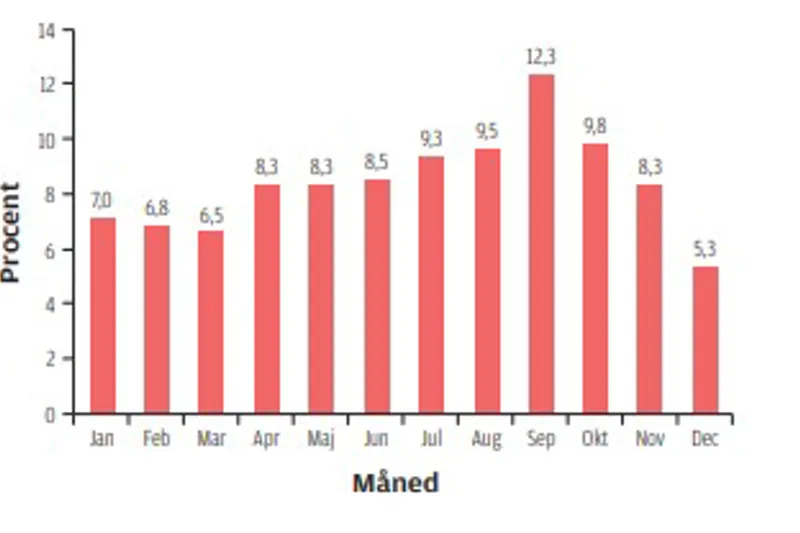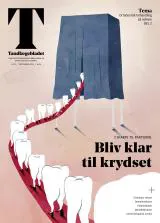Fraktur af collum mandibulae. En retrospektiv opgørelse i Region Hovedstaden
Formålet med denne artikel er at evaluere demografiske data tilknyttet patienter med isoleret mandibelfraktur samt fraktur af collum mandibulae med fokus på månedlig fordeling af frakturer i løbet af året og forholdet mellem alder, ætiologi, køn og frakturmønster (unilateral eller bilateral).

Introduktion – Fraktur af collum mandibulae er en af de hyppigst forekommende typer af mandibelfrakturer. Den rapporterede hyppighed varierer imellem 18,8-42 %. Skadesmekanismen er multifaktoriel og varierer bl.a. i forhold til geografi, socioøkonomisk status, befolkningstæthed og kulturel forskellighed.
Materiale og metoder – Retrospektiv undersøgelse af konsekutivt konservativt og kirurgisk behandlede patienter med isoleret collum mandibulae-fraktur i perioden 2011-2015. Demografiske data som månedsfordeling, alder, køn og ætiologi blev indsamlet.
Resultater – 398 patienter blev inkluderet med i alt 481 collum mandibulae-frakturer. 84 (21 %) var bilaterale, og 314 (79 %) var unilaterale. Den gennemsnitlige alder på skadestidspunktet var 47,7 år, og ratioen mellem mænd og kvinder var 1,23:1. De hyppigste årsager til fraktur var fald (42,7 %), cykelstyrt (32,4 %) og vold (15,8 %). Kvinder havde en signifikant højere risiko for fraktur som følge af cykelstyrt (P = 0,00465), hvorimod mænd havde en signifikant højere risiko for fraktur forårsaget af vold (P = 1,364*10–10).
Konklusion – Kønsfordelingen viser en signifikant større forekomst af collum mandibulae-frakturer hos mænd, men der ses generelt en udligning af kønsforskellen over tid. Der ses størst risiko for bilaterale frakturer ved højenergitraumer som fald og cykelstyrt, hvorimod lavenergitraumer, som fx vold, primært resulterede i unilaterale frakturer.
Klinisk relevans:
Frakturer af collum mandibulae er en hyppig, men desværre ofte overset skade på skadestuer (1). Kendskab til symptomer, hyppighed, skadesmekanisme, alder og køn kan hjælpe til korrekt diagnostik og henvisning til udredning på de kæbekirurgiske hospitalsafdelinger fra såvel kommunal som privat tandlægepraksis. Således kan denne artikel bidrage til større fokus på sufficient udredning ved modtagelse af patienter, der har været udsat for traume mod mandiblen.Fracture of collum mandibulae. A retrospective analysis from copenhagen region.
Introduction – Mandibular condyle fractures are among the most frequent fractures of the mandible accounting for 18.4-42 % of cases reported in the literature. The etiology of mandibular fractures in a population is multifactorial and varies among on differences in socioeconomic status, geographical location, population density and culture.
Material and methods – Retrospective analysis of consecutive treated patients with isolated mandibular condyle fractures in the period from 2011-2015. Demographic data such as the month of the injury, age, sex and etiology were collected.
Results – 398 patients with 481 mandibular condyle fractures were reviewed. In total 314 (79%) patients had unilateral fractures and 84 (21%) had bilateral fractures. The average age was 47.7 years, and the male to female ratio was 1.23:1. The leading causes of mandibular condyle fracture were falls (42.7%), followed by bicycle accidents (32.4%), and violence (15.8%). Females had a significantly higher risk of incurring fractures due to bicycle accidents (P = 0.00465) while males had a significantly higher risk of sustaining a fracture caused by violence (P = 1.364*10–10).
Conclusion – Although the sex distribution showed a significantly higher occurrence of fractures in the male group, the ratio seems to be equalizing over time. Furthermore, aetiologies involving a considerable force (falls and bicycle accidents) resulted in an increased risk of bilateral fractures compared to aetiologies with less force (interpersonal violence).


